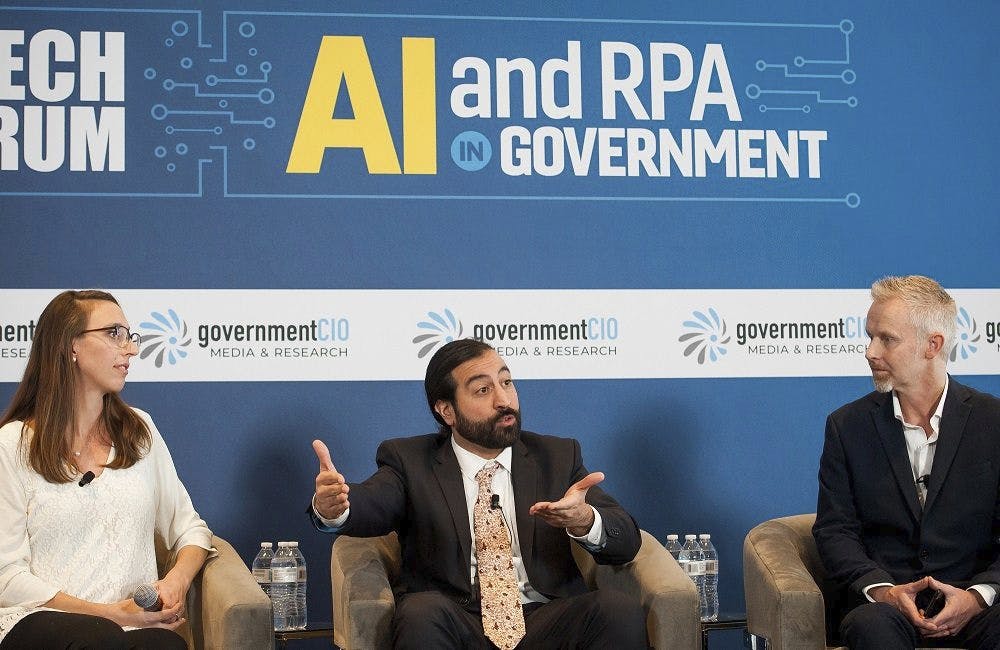JAIC, GSA Collaboration Driving AI Solutions Into Acquisition Processes
DOD’s AI center is helping GSA implement AI across government.

General Services Administration acquisition leads hinted how the agency’s collaboration with the Defense Department’s Joint Artificial Intelligence Center is not only scaling up procurement practices with AI, but informing how civilian agencies can learn from the partnership with their own AI-driven acquisition processes.
GSA Centers of Excellence Acquisition Leads Omid Ghaffari-Tabrizi and Michelle McNellis spoke about the GSA-JAIC partnership GovernmentCIO Media & Research’s AI and RPA CXO Tech Forum, where they explained how implementing agile, internal processes innovations and other practices are driving that cooperation.
The partnership with JAIC is currently in its beginning stages, which include internal strategizing, McNellis said. The partnership involves two contracting shops — a main one that focuses on procuring technologies for DOD and a counterpart in GSA, added Ghaffari-Tabrizi. The setup, he said, has helped GSA’s Centers of Excellence grow AI capabilities and acquisition.
“We’re trying to take a lot of what we’re doing with JAIC — with the national mission initiatives that they work with, and all of the AI that we’re procuring for them — and we’re also hoping to procure for ourselves and make sure [we] implement a lot of these technologies within our own processes,” Ghaffari-Tabrizi said.
GSA and its Centers of Excellence often focus on satisfying the mission of its project teams, so the centers themselves do not get the opportunity to look at what they need to procure to support the centers’ own team members, Ghaffari-Tabrizi added. With the partnership, however, GSA can move toward adopting its own AI-driven tools, such as a chatbot that can answer various acquisition-related questions.
“One of the things I’m trying to do internally is try to figure out a way that I could get a knowledge repository of frequently asked questions that we get internally, just about procurements in general,” McNellis said. “I’m not a technical person. I’m an acquisitions person, so I need to rely on my technical team to figure out a way — once I get these types of questions — how do I make it so that we can maybe make a chatbot or something along those lines?”
One of the most painstaking processes in acquisition is in lead time, so she said that automating the processes between the different steps would be another way she could envision speeding up the procurement of innovative technologies in both defense and civilian agencies, McNellis said. With the pace of technological change, she said this would keep agencies modernized and technologically up-to-speed.
Baking automated solutions into the acquisition process could also help industry partners out, McNellis and Ghaffari-Tabrizi said. McNellis said that the Centers of Excellence have a request for information up at all times to encourage constant engagement with industry rather than have stovepiped RFIs and pre-solicitation processes. Ghaffari-Tabrizi said that if the centers could implement AI to help process questions and answers to the RFI, solicitations can better incorporate feedback.
“We want that rapid-fire feedback loop to be open as long as we can have it open, have it as responsive and dynamic as possible,” Ghaffari-Tabrizi said, “because everything we can learn during that period is what we’ll bake into the solicitations we’ll end up putting out.”
While the two acquisition leads expressed enthusiasm about the possibilities that will come from their new partnership with JAIC, they added that increased perspectives into their work overall will only drive automation into acquisition in better ways. Working with DOD has enabled more acquisition and technical experts, as well as end-user feedback, but McNellis and Ghaffari-Tabrizi said they are also open to academic and industry input.
This is a carousel with manually rotating slides. Use Next and Previous buttons to navigate or jump to a slide with the slide dots
-

Federal Leaders Revamp Tech Workforce, Policy
Despite the rise in interest of emerging technology, federal leaders see data, policy and the workforce as a best vehicle for change.
4m read -

Pentagon Selects Second Tranche of Replicator Drone Program
The second tranche of systems is part of the DOD’s two-year plan to field thousands of autonomous systems by August 2025.
5m read -

Looking Back at the First Trump Administration's Tech Priorities
In his first term, Donald Trump supported cybersecurity, space policy and artificial intelligence development.
4m read -

Securing the Expanding Attack Surface in Cyberspace
Agencies undergoing digital transformation face a more intricate threat landscape and a wider threat target for adversaries looking to exploit vulnerabilities. This panel dives into strategies agencies are undertaking to safeguard these complex environments, including zero-trust architecture, vigilant monitoring and robust cybersecurity training.
30m watch








